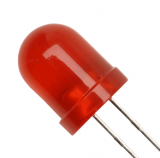Difference between revisions of "GPIO"
Grovkillen (talk | contribs) |
Grovkillen (talk | contribs) |
||
| Line 15: | Line 15: | ||
{| class="wikitable mw-collapsible sortable" | {| class="wikitable mw-collapsible sortable" | ||
| − | ! style="width: | + | ! style="width: 15%|Command |
! GPIO | ! GPIO | ||
| − | ! style="width: | + | ! style="width: 15%|Value |
! Information | ! Information | ||
! style="width: 25%|HTTP example | ! style="width: 25%|HTTP example | ||
Revision as of 19:41, 22 October 2017
Contents
Introduction
The ESP module can control things with it's build-in GPIO output pins. We can turn these on or off or we can set these pins to a special Pulse modulated value (PWM output). And it's also possible to send short pulses (single puls) to one of these pins to control specific devices that are switched with a single short high or low signal.
Hardware
It's best to connect a LED to the GPIO to test your setup. You could dim this LED with the PWM mode commands. Be aware that the ESP8266 only supplys 3,3v at a max current of only ~10mA.
ESP Easy
You dont need a Device definition (task) to control basic GPIO output. You can always control all the pins by HTTP.
Commands
| Command | GPIO | Value | Information | HTTP example | MQTT example (topic: <MQTT subscribe template>/cmd) |
|---|---|---|---|---|---|
| GPIO,<gpio>,<value> | 12...16 | 1 (HIGH) or 0 (LOW) |
Basic on/off. We can control a pin with simple http url commands. To change the pin to high or low steady output | http://<espeasyip>/control?cmd=GPIO,12,1 http://<espeasyip>/control?cmd=GPIO,12,0 |
GPIO,12,1 GPIO,12,0 |
| PWM,<GPIO>,<value> | 12...16 | 0...1023 | To set a certain PWM level. If you have set a certain GPIO to a PWM level and want to use it as a regular HIGH/LOW pin you need to reset by setting the PWM level to 0. | http://<espeasyip>/control?cmd=PWM,13,500 http://<espeasyip>/control?cmd=PWM,13,0 |
PWM,13,500 PWM,13,0 |
Short pulses
To send a pulse to a certain pin:
http://<ESP IP address>/control?cmd=Pulse,<pin>,<state>,<duration>
Example to send an active high pulse on GPIO 2 for 500 mSeconds:
http://<ESP IP address>/control?cmd=Pulse,2,1,500
Long pulses
A long pulse is basically the same as the plain pulse. The only difference is the time base in seconds rather than in milliseconds. So it's more suiteable for longer durations. To send a long pulse to a certain pin:
http://<ESP IP address>/control?cmd=LongPulse,<pin>,<state>,<duration>
Example to send an active high pulse on GPIO 2 for 10 minutes:
http://<ESP IP address>/control?cmd=LongPulse,2,1,600
Servo motor control
To control a Servo Motor:
http://<ESP IP address>/control?cmd=Servo,<servo nr>,<pin>,<position>
We currently support a maximum of two servo motors so you can build a pan & tilt device if you like.
Example to set servo 1 on gpio-0 to a 90 degree position and servo 2 on gpio-2 to a 45 degree position:
http://<ESP IP address>/control?cmd=Servo,1,0,90 http://<ESP IP address>/control?cmd=Servo,2,2,45
Tones, melodies and ringtones
For using tone and rtttl commands you should head over to the Buzzer (RTTTL) section.
